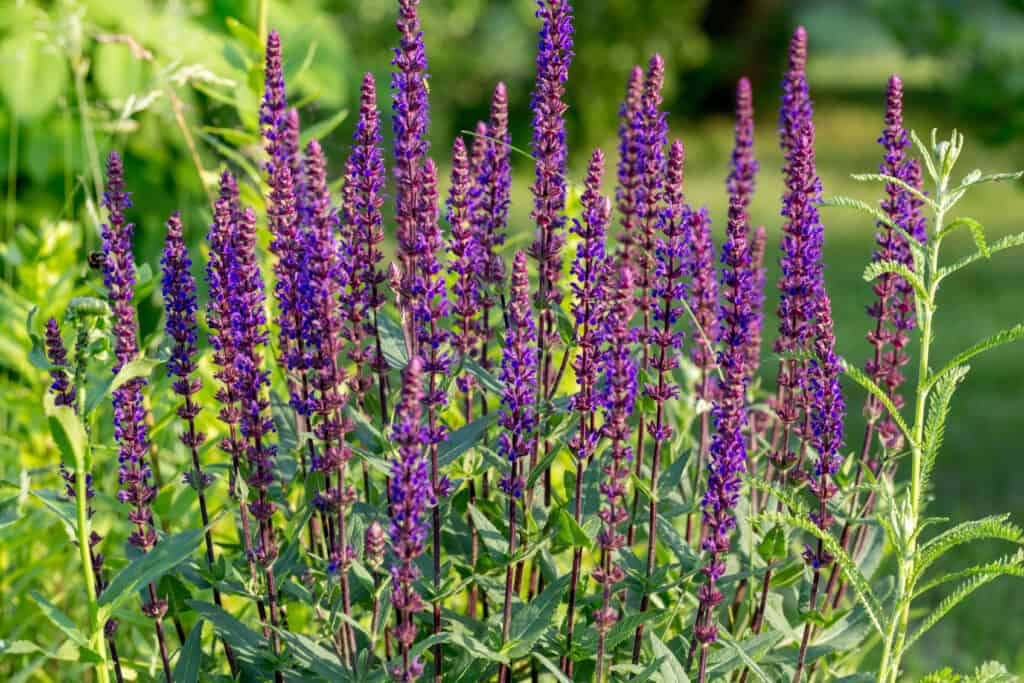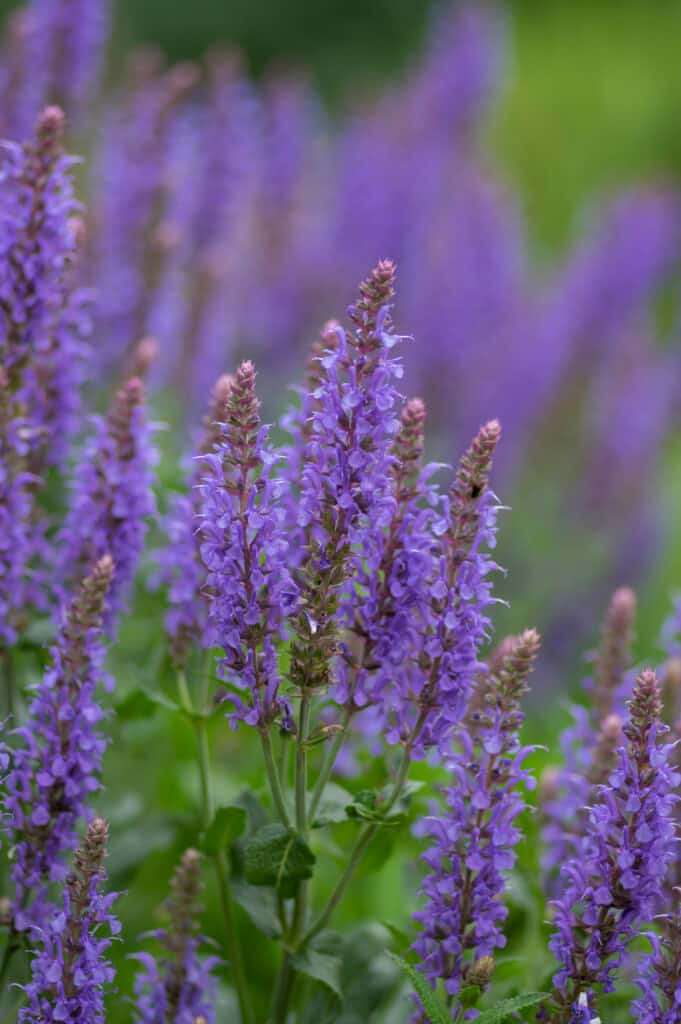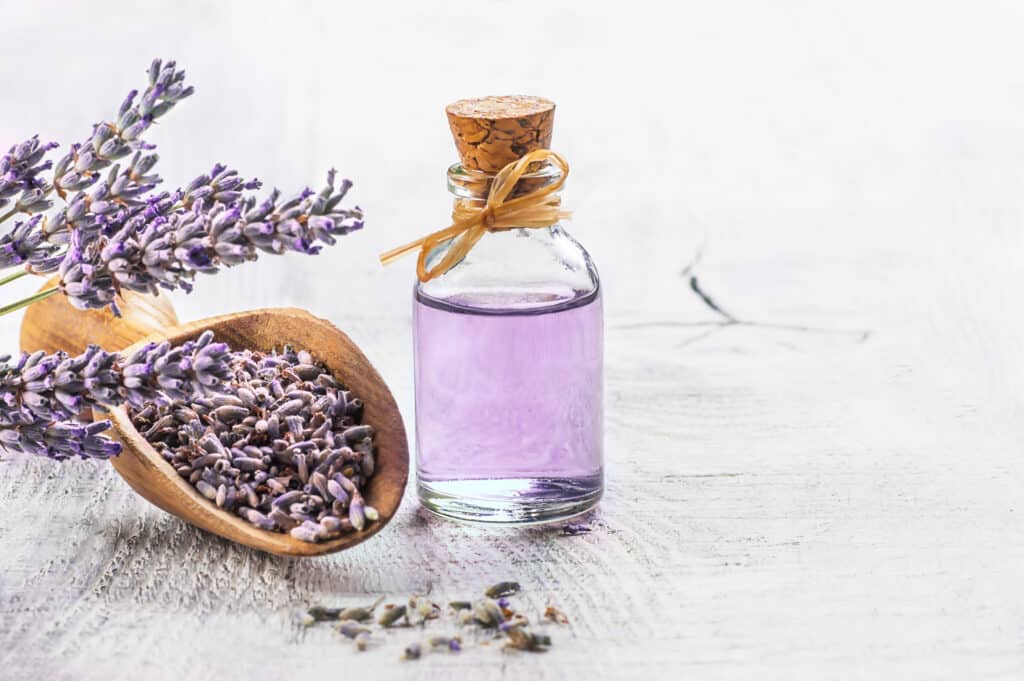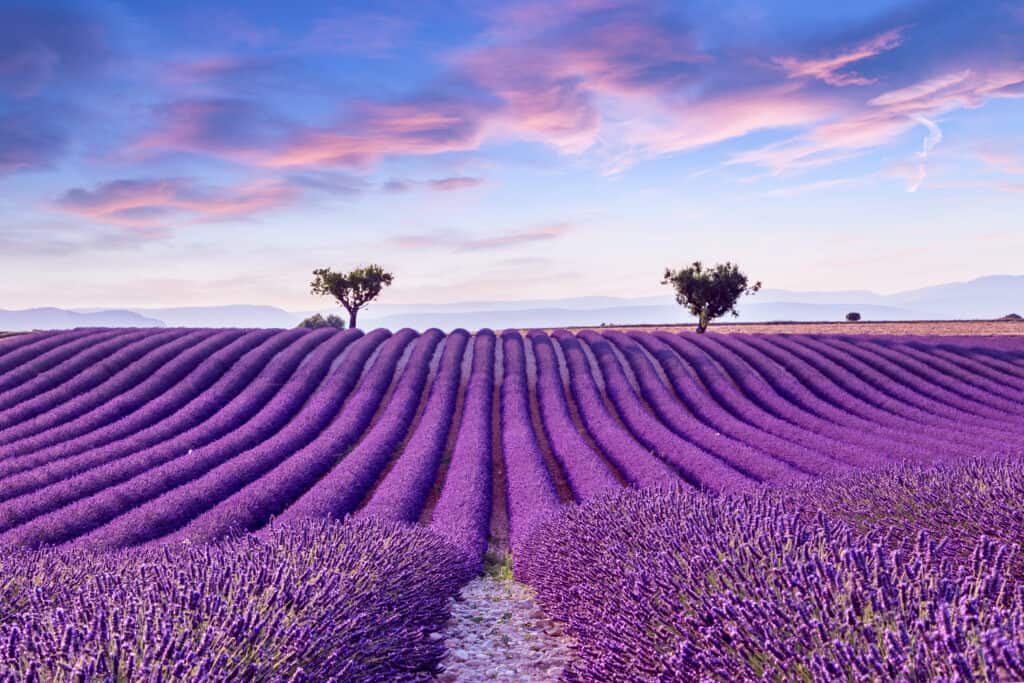Salvia and Lavender are two gloriously purple plants that may be mistaken for each other. In many cases, there’s not a big deal about confusing two flowering plants, but in this case, you might seriously regret choosing the wrong purple blooms to nosh on. Yes, both salvia and lavender are edible plants, but they have very different impacts when you eat them and very different side effects and uses, too. Be sure to read all the way through to learn the intriguing differences of salvia vs. lavender.

Gorgeous salvia is often mistaken for lavender.
©Olga_Ionina/Shutterstock.com
| Salvia | Lavender | |
|---|---|---|
| Classification | Salvia officinalis; 3,000 different plants in this category | Lavandula; 47 known species of lavender |
| Description | Salvia may be grown as shrubs, herbs, or subshrubs, with opposing leaf formations and occasional purple flowers on stalks with two lips and two stamens. | Lavender is a flowering shrub with gray-green leaves and purple to blue flowers on stalks spreading out from the middle of the plant. |
| Uses | Salvia is a plant many used with caution, due to its hallucinatory properties. However, it makes a lovely ornamental and aromatic plant for the garden and attracts pollinators. | Lavender is used for many herbal remedies and treatments for stress, insomnia, and pain, as well as a flavor add-on for sweets and teas. It is also used for flower arrangements, essential oils, and cleansers. |
| Origin and growing preferences | Salvia originated in the Sierra Mazateca region of Oaxaca, Mexico. It requires plenty of sunshine and well-drained soil and cannot survive extremely cold temperatures outdoors. | Lavender has been around for as long as we’ve had written records, appearing as early as the Old Testament days through Ancient Egyptian and Roman times. The plant needs to be planted in full sun with sandy, well-drained soil. |
| Special features and fun facts | Salvia has a long history dating back to the Mazatec culture, in which the shamans used the herb to conjure visions and perform other rituals. It was also used by ancient Romans and Greeks to preserve foods. | Lavender’s name means “to wash” and the plant in various forms has often been used to replace soap. It also represents purity, devotion, calmness, and serenity. |
Key Differences Between Salvia and Lavender
These two gorgeous flowers are equally worth savoring in your garden space, but there are some significant differences you’ll want to consider before you get to planting.
Salvia vs. Lavender: Classification
Salvia officinalis is a highly fragrant perennial shrub that belongs to the mint family, Lamiaceae. The plant is sometimes called culinary sage, garden sage, or common garden sage. There are upward of 3,000 different plants in the Lamiaceae family of sage. There are shrubs, annuals, and herbaceous perennials in this category.
Lavender is also a highly fragrant flowering plant in the mint family, Lamiaceae. Lavandula, though is either an annual or a short-lived herbaceous perennial plant that may be a shrub or subshrub. There are at least 47 known species of lavender that have been cultivated around the world. You may find this plant referred to as lavender, true lavender, medical lavender, smelling lavender, English lavender, or thin-leaved lavender, though English lavender is a specific form within the family of lavender.

Salvia plants don’t always have flowers but when they do, they’re absolutely stunning!
©Iva Vagnerova/Shutterstock.com
Salvia vs. Lavender: Description
Salvia plants may grow as herbs, shrubs, or subshrubs, depending on the specific species of the perennial plant. The leaves may either compound or simple, with arrangements opposite along the square stems. The purple flowers, though not as prevalent as many think are tubular and have two lips and two stamens. They produce nutlet fruits and attract hummingbirds and other pollinators.
Lavender is a perennial or annual shrub, depending on its growing conditions and methods. They are usually small with branching arms that spread out from a core, with gray-green leaves and long, flowering stalks. The leaves may be simple or compound. The flowers themselves are typically thought of as purple, but they may come in pale blue, lilac, lavender, or other similar shades, not merely the violet color most often seen in photos. The plant may grow up to 1.3 feet tall and live for up to 30 years.

Salvia flowers are uniquely shaped with two stamens and two lips.
©olko1975/Shutterstock.com
Salvia vs. Lavender: Uses
If you want to grow some salvia plants at home, there are some precautions you should consider beforehand. The plant has been used for a drug for many centuries. It produces visual hallucinations that may be quite intense. In the days way back, shamans used it specifically to produce these visionary experiences and to perform rituals with. There are concerns that the plant can cause some risks. Because of these risks, some choose not to plant the flowering shrub/herb in their home gardens.
However, for those who wish to grow the plant for its lovely flowers, it is a highly aromatic plant that attracts pollinators like butterflies and hummingbirds and adds some lovely visual qualities to the aesthetics of any outdoor space.

Lavender is used for many internal and external remedies.
©Halil ibrahim mescioglu/Shutterstock.com
Lavender, on the other hand, is a much safer herb to grow and use for personal use. The plant has been used for flower arrangements for its vibrant colors and unique textures, as well as its lovely fragrance, as well as for essential oils, soaps, cleansers, skin care products, sleep care products, and more. The flower is often used to soothe anxiety and stress, insomnia, depression, and in some case, pain. It is believed to have antifungal and antibiotic affects.
Lavender is often used in teas, flavor additives in syrups and honey, sauces, and as garnish or flavoring for sweet treats like macarons and cakes.
Salvia vs. Lavender: Origins and Growing Preferences
Salvia originated in the Sierra Mazateca region of Oaxaca, Mexico. It is still used by the Mazatec people today, primarily for shamanistic purposes. The plant’s history is limited from the general public’s perspective. It is generally accepted to be a wild native plant to the area where it began a cultigen of the Mazatecs or a nearby indigenous group. Botanists have not yet been able to tell if it a cultigen or hybrid, however, so there is much left up to speculation on the plant.
For those wishing to growing salvia, you’ll want to find a place in the garden with full sun and well-drained soil. It is a successful raised bed plant, potted plant, and in-ground plant, but it must not be let to get too wet in cold weather. The soil should be kept moist throughout the warmer seasons, however, and ideally brought indoors in cold months if you live in regions with extreme temperature drops.
Lavender has been in human knowledge for well over 2,500 years. If you read the Old Testament, you’ll find it referenced to as spikenard. Ancient Egyptians used the plant for their perfumes and mummification process. Romans used lavender oils in bathing, cooking, and perfumery. The plant was carried throughout the Roman Empire before it made its way to Medieval and Renaissance France and ultimately into London where it was used as a hopeful preventative of the Black Death in the 1600s. The plant was brought the Americas as settlers came, with particular note among the Shaker communities growing it commercially.
When you plant lavender at home, you’ll want to wait until the last chances of frost have passed. Plant the flower in raised beds, container gardens, or traditional in-ground garden plots, placing them 12 to 18 inches apart. Be sure they’re where they will get plenty of sunlight and, ideally, in sandy soil that is well-drained.

Fields of lavender attract tourists from around the world.
©Fesus Robert/Shutterstock.com
Salvia vs. Lavender: Special Features and Fun Facts
Salvia is an interesting plant with some, well, interesting facts to accompany it as a garden flower. In way back times, there were some shamans of the Mazatec culture who took salvia to help them receive visions. They also used it for various other ritual performances. The plant’s name also means to “feel well and healthy” and it was once used by ancient Greeks and Romans to preserve meat and, oddly, as a memory enhancer. It was also used to ward off evils and biting serpents.
Lavender is perhaps a more commonly familiar plant with the wide audience, but there are some pretty interesting things going on here, too. For example, lavender’s name comes from the Latin word that means “to wash.” It has often been as a replacement for soap for cleansing, so the name makes sense! The plant is also highly symbolic, representing purity, devotion, serenity, and calmness. And given its soothing properties, that also makes a lot of sense.
Next Up:
- Chrysanthemum vs. Daisy
- Plants That Repel Mosquitoes
- Plants That Repel Spiders
- Astrological Gardening: What to Plant Based on Your Zodiac Sign
The photo featured at the top of this post is © Iva Vagnerova/Shutterstock.com
Sources
- Wisconsin Horticulture Division of Extension, Available here: https://hort.extension.wisc.edu/articles/sage-salvia-officinalis/
- Science Direct, Available here: https://www.sciencedirect.com/topics/medicine-and-dentistry/lavandula
- Britannica, Available here: https://www.britannica.com/plant/Salvia
- Plant Village, Available here: https://plantvillage.psu.edu/topics/lavender/infos
- Medical News Today, Available here: https://www.medicalnewstoday.com/articles/309735
- WebMD, Available here: https://www.webmd.com/vitamins/ai/ingredientmono-838/lavender
- BHG, Available here: https://www.bhg.com/gardening/flowers/lavender-facts/
- Bonnie Plants, Available here: https://bonnieplants.com/blogs/how-to-grow/growing-lavender
Thank you for reading! Have some feedback for us? Contact the AZ Animals editorial team.






